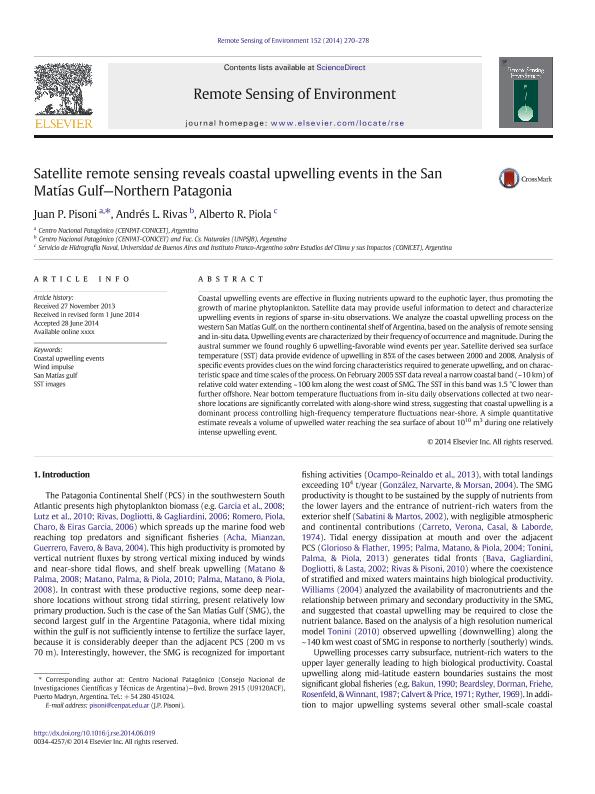Mostrar el registro sencillo del ítem
dc.contributor.author
Pisoni, Juan Pablo

dc.contributor.author
Rivas, Andres Lujan

dc.contributor.author
Piola, Alberto Ricardo

dc.date.available
2016-12-07T21:14:03Z
dc.date.issued
2014-09
dc.identifier.citation
Pisoni, Juan Pablo; Rivas, Andres Lujan; Piola, Alberto Ricardo; Satellite remote sensing reveals coastal upwelling events in the San Matías Gulf?Northern Patagonia; Elsevier; Remote Sensing Of Environment; 152; 9-2014; 270-278
dc.identifier.issn
0034-4257
dc.identifier.uri
http://hdl.handle.net/11336/9043
dc.description.abstract
Coastal upwelling events are effective in fluxing nutrients upward to the euphotic layer, thus promoting the growth of marine phytoplankton. Satellite data may provide useful information to detect and characterize upwelling events in regions of sparse in-situ observations. We analyze the coastal upwelling process on the western San Matías Gulf, on the northern continental shelf of Argentina, based on the analysis of remote sensing and in-situ data. Upwelling events are characterized by their frequency of occurrence and magnitude. During the austral summer we found roughly 6 upwelling-favorable wind events per year. Satellite derived sea surface temperature (SST) data provide evidence of upwelling in 85% of the cases between 2000 and 2008. Analysis of specific events provides clues on the wind forcing characteristics required to generate upwelling, and on characteristic space and time scales of the process. On February 2005 SST data reveal a narrow coastal band (~10 km) of relative cold water extending ~100 km along the west coast of SMG. The SST in this band was 1.5 °C lower than further offshore. Near bottom temperature fluctuations from in-situ daily observations collected at two nearshore locations are significantly correlated with along-shore wind stress, suggesting that coastal upwelling is a dominant process controlling high-frequency temperature fluctuations near-shore. A simple quantitative estimate reveals a volume of upwelled water reaching the sea surface of about 1010 m3 during one relatively intense upwelling event.
dc.format
application/pdf
dc.language.iso
eng
dc.publisher
Elsevier

dc.rights
info:eu-repo/semantics/openAccess
dc.rights.uri
https://creativecommons.org/licenses/by-nc-nd/2.5/ar/
dc.subject
Coastal Upwelling Events
dc.subject
Wind Impulse
dc.subject
San Matías Gulf
dc.subject
Sst Images
dc.subject.classification
Oceanografía, Hidrología, Recursos Hídricos

dc.subject.classification
Ciencias de la Tierra y relacionadas con el Medio Ambiente

dc.subject.classification
CIENCIAS NATURALES Y EXACTAS

dc.title
Satellite remote sensing reveals coastal upwelling events in the San Matías Gulf?Northern Patagonia
dc.type
info:eu-repo/semantics/article
dc.type
info:ar-repo/semantics/artículo
dc.type
info:eu-repo/semantics/publishedVersion
dc.date.updated
2016-11-23T19:41:17Z
dc.journal.volume
152
dc.journal.pagination
270-278
dc.journal.pais
Países Bajos

dc.journal.ciudad
Amsterdam
dc.description.fil
Fil: Pisoni, Juan Pablo. Consejo Nacional de Investigaciones Científicas y Técnicas. Centro Nacional Patagónico; Argentina
dc.description.fil
Fil: Rivas, Andres Lujan. Consejo Nacional de Investigaciones Científicas y Técnicas. Centro Nacional Patagónico; Argentina
dc.description.fil
Fil: Piola, Alberto Ricardo. Ministerio de Defensa. Armada Argentina. Servicio de Hidrografia Naval; Argentina
dc.journal.title
Remote Sensing Of Environment

dc.relation.alternativeid
info:eu-repo/semantics/altIdentifier/url/http://www.sciencedirect.com/science/article/pii/S0034425714002399
dc.relation.alternativeid
info:eu-repo/semantics/altIdentifier/doi/http://dx.doi.org/10.1016/j.rse.2014.06.019
Archivos asociados
